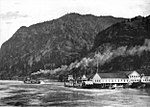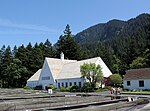Pierce National Wildlife Refuge
The Pierce National Wildlife Refuge is in southwest Washington within the Columbia River Gorge National Scenic Area. It encompasses wetlands and uplands along the north shore of the Columbia River west of the town of North Bonneville. Refuge habitats include wetlands, Columbia River riparian corridor blocks, transitional woodlands from willows to cottonwood/ash to white oak to Douglas fir, improved pastures with some native grasses, and numerous creeks, seeps, and springs.Hardy Creek, which bisects the refuge from east to west, supports one of the last remaining runs of chum salmon on the Columbia River. The creek also supports small remnant runs of coho salmon, steelhead, and Chinook salmon as well as a variety of native species of freshwater fish. The refuge headquarters also serves as the main office for Steigerwald Lake and Franz Lake National Wildlife Refuges. Visitor opportunities are limited to arranged group tours and viewing from the summit of Beacon Rock and the Hamilton Mountain Trail (both located in Beacon Rock State Park).
Excerpt from the Wikipedia article Pierce National Wildlife Refuge (License: CC BY-SA 3.0, Authors).Pierce National Wildlife Refuge
Cascade Drive,
Geographical coordinates (GPS) Address Nearby Places Show on map
Geographical coordinates (GPS)
| Latitude | Longitude |
|---|---|
| N 45.6301 ° | E -122.0003 ° |
Address
Pierce National Wildlife Refuge
Cascade Drive
98639
Washington, United States
Open on Google Maps






